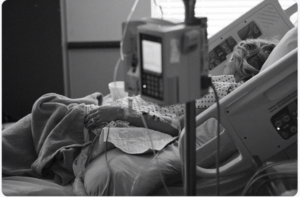Roberta Heale, Associate Editor EBN @robertaheale @EBNursingBMJ
About 25 years ago my Mom underwent a surgical procedure which required her to be in intensive care for several days. She recalls that one night while she was in the ICU, she was surprised to see that all the nurses caring for her were very tiny…far shorter than the height of the mattress on the bed. She protested when the nurses tried to turn her and insisted that they call my father. It was only when he arrived and also appeared to be very tiny, that she realized things weren’t right. We laugh about it now, but delirium in ICU is no laughing matter. Characterized by confusion, hallucinations, unresponsiveness, or agitation, delirium can put patients at risk for longer hospital stays, long-term brain dysfunction or death.1
Unfortunately, delirium is very common. Estimates in ICU range from 30-80 percent, particularly for intubated patients 2Early detection of delirium is imperative for ensuring prompt treatment.3 Several tools can be used to assess patients for delirium in ICU including the RASS (Richmond Agitation-Sedation Scale) and the CAM-ICU (Confusion Assessment Method for the ICU). Both are reliable, validated and simple to use. The RASS, as the name suggests, is a scale of levels of agitation and restlessness. Patients are given a score which prompts for treatment or assessment of delirium. https://bit.ly/2QjcpBf The CAM-ICU incorporates a RASS score of > -3 (increasing signs of agitation) along with assessment of change of mental status, attention and response to questions and commands to determine if a patient is suffering from delirium. https://bit.ly/2PWw3na These tests should be administered daily for all ICU patients to determine if they have developed delirium, or to assess the effectiveness of treatment for delirium.
ICU nurses are ideally suited to implement assessments for delirium in their patients. They have expert knowledge and skills and, because they are with patients for the length of a shift, they are best able to determine if there are changes in the patients’ behaviour or mental status. Nurses collaborate with other health care providers to ensure that delirium is recognized and treated. They are also often the first and most consistent contact of family members. As such, nurses can provide education and support for both patients and their families during this difficult time, as they did with my parents many years ago.
1. Leung, W. (2018). ‘Like brain failure’: Researchers working to prevent delirium among hospital patients. Globe and Mail, Nov 18, 2018https://tgam.ca/2FEWeKp
2. Cavallazzi, R., Saad, M. & Marik, P.E. (2012). Delirium in the ICU: an overview. Annals of Intensive Care. 2(49).
3. Harroche, J., St-Louis, L. & Gagnon, M. (2014). The detection of delirium in the ICU: An important aspect of care. Journal of Nursing Education and Practice, 2014 4(9).